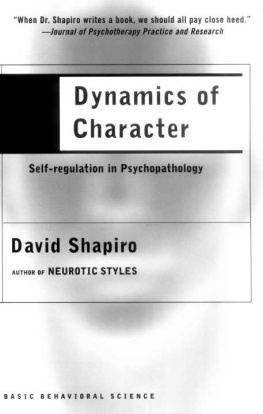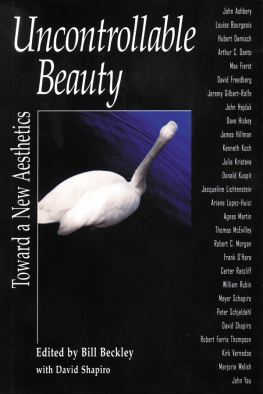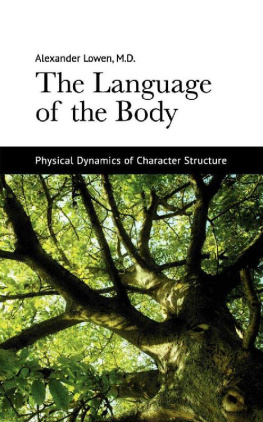


In memory of my brother, Arthur Shapiro
Contents
SECTION ONE
STRUCTURE AND DYNAMICS
SECTION Two
PSYCHOPATHOLOGY, AGENCY, AND VOLITION
SECTION THREE
NEUROSIS AND PSYCHOSIS
Acknowledgments
I would like once again to express my gratitude to my friend Dr. Jean Schimek for his critical reading of the manuscript in the face of my own impatience. I have been fortunate, also, to have the assistance of Mustafa Atakay, Murat Paker, M.D., and Michael Jackson during various phases of the writing and preparation of the book and I wish to thank each of them for their valuable help. My editor, Cindy Hyden, of Basic Books has been exceedingly helpful in the book's preparation, and I appreciate her work. Finally, I want to thank my wife, Gerry Shapiro, whose advice on innumerable matters in the course of writing has as usual been indispensable.
Some parts of Chapters 1 and 2 have appeared in different form in the journal Social Research, and I am grateful for permission to use that material here.
Preface
For some time I have wanted to extend and also deepen my earlier studies of psychopathology, all the more now in light of the current challenge to psychological understanding from biological science. My earlier work on neurotic styles attempts to describe quite closely the formal qualities of various kinds of neurotic experience and behavior, such as the ways of thinking, the attitudes (particularly the unrecognized attitudes), and the modes of action that characterize the different neurotic conditions. I was interested in the description and analysis of the general forms of pathological experience and behavior because these forms or styles seemed to constitute what might be called the structure of the pathological character and, in turn, determined the form of characteristic symptoms.
The study of the ways the mind works, of what Wilhelm Reich called "ways of being," necessarily leads to a different perception of the dynamics of psychopathology from the traditional psychoanalytic one. It leads to a picture of a consciously purposeful individual whose activity and the attitudes that shape it are not mere products of the pathological dynamics but are central to those dynamics. It is a more inclusive dynamics, one that includes the defensive function of the individual style of cognition and action, the subjective forms of motivation, and the qualities of conscious experience in general. This dynamics of the whole character is, in my opinion, a view of the individual's self-regulation that is sounder theoretically and more useful therapeutically than the traditional dynamics of drive-defense conflicts. In particular, it opens the door to a better understanding of the subjective necessity of the forms that symptoms take.
One of the unexpected products of my earlier work was the suggestion of certain formal relations or kinships between kinds of psychopathology that were symptomatically quite disparate, such as between obsessional and paranoid conditions. Further formal analysis, I have thought, might permit an understanding of psychopathology in terms of still more fundamental dimensions and a clearer picture of the relations of the various kinds of psychopathology to one another, and also of dynamic processes common to them.
In particular, I have long been impressed with the fact that the symptomatic behavior of all the different kinds of psychopathology is characterized clinically either by a comparatively unreflective, spur-of-the-moment planlessness, on the one hand, or rigidity, direction by fixed internal rules, on the other. Both of these are modes of activity that entail a diminished volitional experience. That is, they entail a diminished experience of self-direction (as in decision), or personal responsibility, or agency. It is not hard to see the defensive or anxiety-forestalling value of such modes of action.
My interest in more fundamental dimensions of psychopathology has been focused especially on that idea, on determining whether the various forms of psychopathology can be understood as varieties of general modes of diminished agency. It is not my aim to reduce all the kinds of psychopathology and the kinds of character from which symptoms arise to a single model. It is, rather, to understand the relations among them and in that way to understand what means of self-regulation they may share.
The fact that we are able to perceive formal relations and kinships among conditions of extremely diverse symptoms, perhaps even across the gap that separates psychotic from neurotic symptoms, has another, more immediate, value. It seems to me a refutation of the idea of diverse, specific causes for those conditions, whether that idea be of particular childhood conflicts or traumas, as so commonly thought in the past, or particular biological defects, so popular at present. The study of the formal structures of psychopathology can, in other words, restrain the temptation, to which our scientifically still-immature field is so susceptible, to find causes that are too simple for complicated conditions.
SECTION ONE
STRUCTURE AND DYNAMICS
CHAPTER ONE
Introduction
This book is written against the current. The medicalization of psychiatry is increasingly apparent, and interest in psychopathology has turned for the moment toward biology. The trend includes a diminished interest in the psychology of psychopathology altogether, but it particularly involves a diminished psychoanalytic influence. One would not have predicted this development thirty or forty years ago. After World War II, psychoanalytic understanding was ascendant in psychiatry, at least intellectually, and its influence was critical in the rapid development of clinical psychology and probably clinical social work as well. Psychoanalysis offered a comprehensive psychological theory of psychopathology, particularly of neurosis. It was, in fact, the only comprehensive and detailed theory in existence. The fact is, if one includes its contemporary modifications, it remains so; it has not been superseded, at least by any other psychological theory. It is therefore all the more striking that psychoanalytic influence has waned in its primary field of discovery. I do not think that this development can be attributed entirely to the advances in neuroscience, or to the effectiveness of pharmacological treatment of some kinds of mental illness. It must be taken, also, as an expression of dissatisfaction and disappointment with the theory itself, and for that matter with psychological theory altogether in this field.
Biological explanation of psychopathology, for its part, is often simplistic. The identification of particular biological processes that may be involved in a condition cannot explain the volitional behavior, the cognitive processes, and the ideational and affective content that ultimately constitute the condition.

















